Felsenkirche Idar-Oberstein
Useful Information
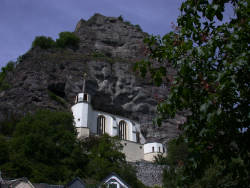
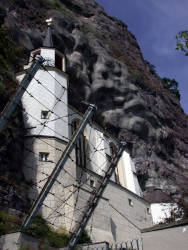
| Location: |
Idar-Oberstein, in Oberstein.
Above the town center, access only by foot. (49.7054434, 7.3287639) |
| Open: |
Unknown. Online booking required. [2023] |
| Fee: |
Adults EUR 5, Children (7-16) EUR 4, Children (0-6) free, Students EUR 4, Disabled EUR 4. [2023] |
| Classification: |
 Cave Church Cave Church
|
| Light: |
 Incandescent Incandescent
|
| Dimension: | L=17 m, W=25 m, H=12 m, V=5,000 m³. |
| Guided tours: |
St=220.

|
| Photography: | allowed |
| Accessibility: | no |
| Bibliography: | |
| Address: |
Evangelische Kirchengemeinde Oberstein, Felsenkirche, 55743 Idar Oberstein, Tel:+49-6781-22840.
Ev. Gemeindeamt Oberstein, Wasenstr. 21, 55743 Idar Oberstein, Tel:+49-6781-22270. Tourist-Information EdelSteinLand, Hauptstr. 419, 55743 Idar-Oberstein, Tel: +49-6781-64871. E-mail: |
| As far as we know this information was accurate when it was published (see years in brackets), but may have changed since then. Please check rates and details directly with the companies in question if you need more recent info. |
|
History
| ~1400 | altarpiece created. |
| 1482 | start of construction. |
| 1484 | completed. |
| 1927-29 | Felsenkirche renovated. |
| 1742 | Felsenkirche damaged so badly by falling rocks that reconstruction did not seem worthwhile. |
| 1980-1981 | entrance tunnel constructed. |
| 1981 | renovation of the church and safety measures for the cliff face completed. |
| 2000 | renovation of the church. |
| 2019 | closed due to falling rocks. |
| 24-SEP-2022 | reopened after rock stabilisation. |
| MAR-2023 | The Felsenkirche can only be visited as part of a guided tour. |
Description
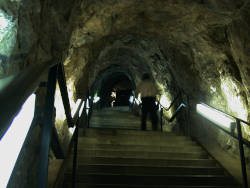
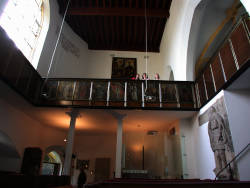
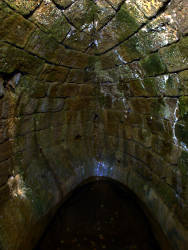
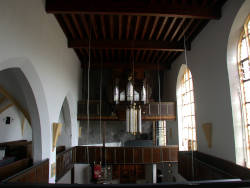
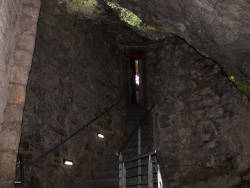
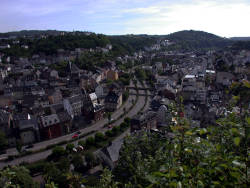
The Felsenkirche, situated in a prominent position above the market square in the middle of an overhanging rock face, is Idar-Oberstein’s landmark. The church is 50 m above the riverbed and 50 m below the ruins of a castle. Buildings were erected on the slope below the church, various pedestrian paths and staircases lead behind these houses up to the church. A special feature is that the houses are not accessible by vehicle, they were built before the invention of cars. As Idar-Oberstein is the centre of the gemstone, jewellery and mineral trade in Germany, almost every one of the buildings houses a mineral shop, jeweller or show-cutting workshop. This makes the climb a little more entertaining, but no less strenuous and, moreover, perhaps even quite expensive if you succumb to the temptation and shop.
The cave of the cave church is a spacious cavity in the rock face. The rock is not karstifyable, so it is not a karst cave. It was probably formed by a small spring in the rock face, the water led to increased weathering around the spring. Especially during winter, the moisture from the spring caused the cave to enlarge due to frost heave. The church was built into the cave in such a way that the rock wall of the cave behind the altar forms the church wall. Normal walls were built on the other three sides and the church also has a normal roof. The roof has the function of keeping the dripping water off the ceiling of the cave. The church fills the cave without protruding significantly, the wall on the valley side closes with the overhanging rock face above. The church was built between 1482 and 1484 by Wyrich IV of Daun-Oberstein.
A legend tells why the church was built on this unusual site, although the spring aspect is unlikely from a geological point of view. Moreover, there are very different versions of the legend, of which we will present only one.
Two brothers, Wyrich and Emich, lived in Bosselstein Castle above the rock face.
Both fell in love with the same woman, Bertha von Lichtenberg.
While Wyrich was away at a battle, Emich became engaged to Bertha without further ado.
When Wyrich returned, he became so angry about this that he threw Emich out of a window of the castle in anger.
Emich fell to his death on a ledge of the rock face.
Now Wyrich was plagued by feelings of guilt and confessed his deed to an abbot, who ordered him to build a church on the spot where his brother died as atonement.
Wymich worked on this for many years.
When it was finished, he asked for a sign that God had forgiven him for his deed, whereupon a spring sprang from the rock, which is still part of the church today.
Bertha, however, with whom both brothers had fallen in love, is said to have entered a monastery.
Old legend.
Even if it cannot be true, the legend is still quite beautiful. The spring is located on the back wall of the church and is beautifully set. However, the amount of water is rather small. It is, as usual, abused by visitors as a dump for coins.
The versions of the legend disagree about how the murder happened. There is a version in which the cousin is accidentally hit by a stray arrow. In another version, one brother put a cat in the other’s boot as a joke, which led to the fatal window fall.
And there is a version of the legend, that he had chiseled out the cave into the rocks with his own hands. The cavern is approximately 25 m long, 17 m deep, with a height in the middle of 12 m. So he would have chiseled 5,000 m³ of porphyrite, at a time when miners were able to build one meter of mine tunnel per year! In fact, except for the fixtures, the cave is more or less in its natural state. And yet this version has a fascinating consistency: after completing the task, the murderer collapsed dead and the perpetrator and victim were then buried together in this church.
While most of the names from the legend actually exist, the legend itself is not supported by the historical record. There was in fact once a murder in the family of the rulers of Oberstein. In 1328 or 1329, Wirich of Daun was killed by his distant cousin Eberhard Bossel of Stein. But the victim was killed one night in his bed, no spectacular defenestration.
The church probably goes back to a predecessor building, a medieval cave castle or hermitage. However, there is no evidence for this, neither archaeological nor written. But the shield wall is 1.90 m thick up to the height of the cornice and has three embrasure-like window openings. This indicates that there was originally a defensive building on this site. In addition, the shield wall has several very irregular bends, and the side lengths and angles of the hexagonal steeple are all different. This would be very unusual for a church, as symmetry was very important for churches at that time. However, it is easily explained by the conversion of a cave castle into a church. Medieval documents repeatedly mention a Unterburg im Tale (lower castle in the valley), sometimes called das Loch (the hole). This theory, however, contradicts the legend.
The church has some exceptional works of art. The greatest treasure is the Medieval, winged altar, which was made around 1400. The Sebastiansbild (image of Sebastian) depicts the family of Count Sebastian of Daun-Oberstein-Falkenstein and was created around 1570. A staircase leads up behind the church through a small unused part of the original cave to a small viewing platform that offers a beautiful view of Oberstein.
The church was originally entered via a small forecourt. Due to the constant danger of rockfall, this path is considered too dangerous and is closed today. Instead, a tunnel was built which leads directly into the church. This fundamental safeguarding of the church took place from 1978 to 1981 and cost 3 million marks. It included the construction of rockfall protection and entrance tunnel as well as the fortification of the rock with concrete. But in 2019, another rockfall occurred and the church had to be closed again. Originally, €300,000 was budgeted for the works, but in fact the measure dragged on for three years and cost €5 million. In the meantime, however, the church has been reopened.
 Search DuckDuckGo for "Felsenkirche Idar-Oberstein"
Search DuckDuckGo for "Felsenkirche Idar-Oberstein" Google Earth Placemark
Google Earth Placemark Protestant Trinity Parish of Nahe Oberstein (visited: 20-FEB-2023)
Protestant Trinity Parish of Nahe Oberstein (visited: 20-FEB-2023) Felsenkirche (Crag Church) - Atlas Obscura (visited: 23-MÄRZ-2025)
Felsenkirche (Crag Church) - Atlas Obscura (visited: 23-MÄRZ-2025) Index
Index Topics
Topics Hierarchical
Hierarchical Countries
Countries Maps
Maps